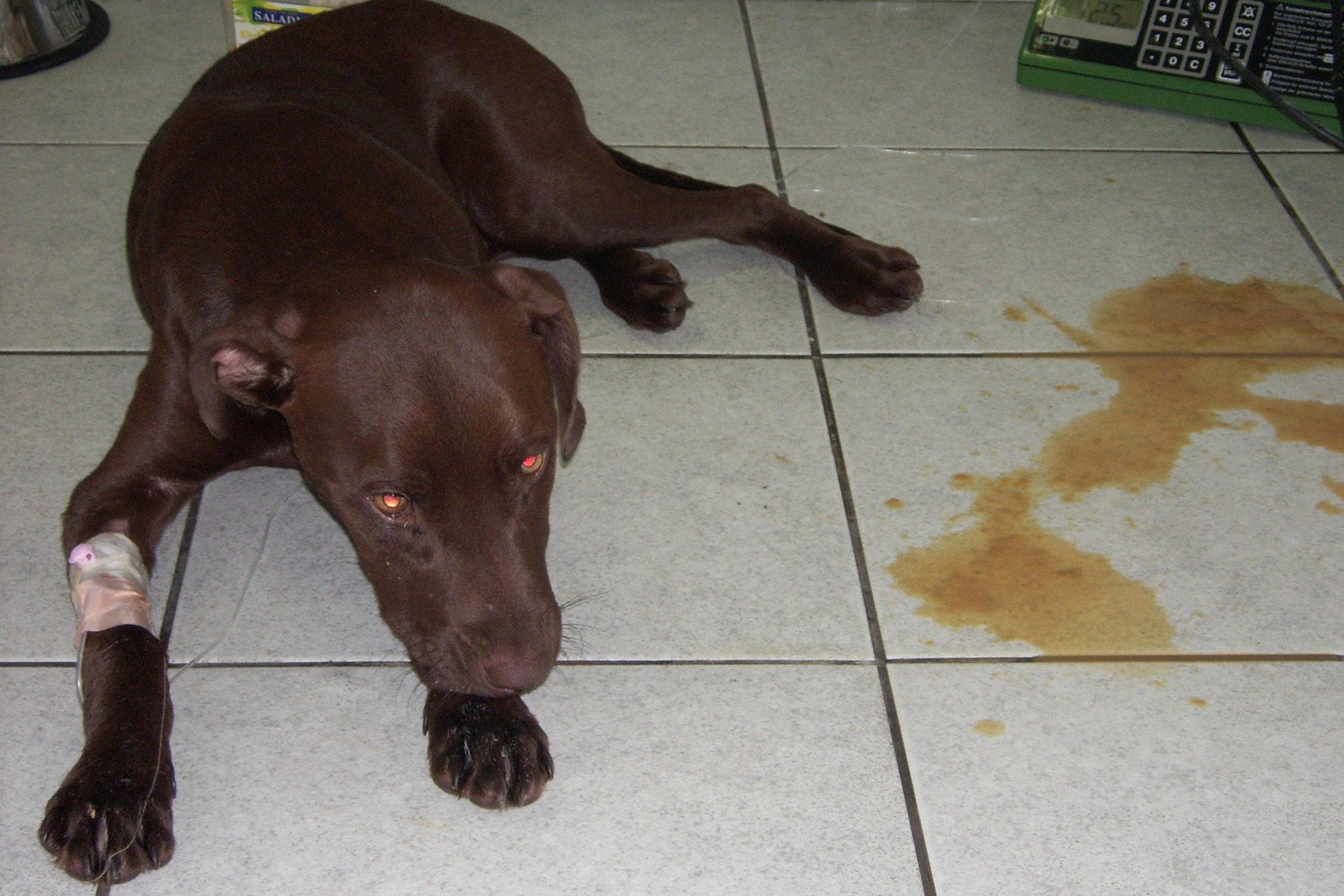My Female Dog Has Vaginal Discharge



See files for Dogs
Vaginal discharge in your dog is abnormal, depending on the context. For example, a pregnant dog will have some discharge if they are about to give birth. When a female dog is not pregnant or is not even sexually intact, vaginal discharge can be a worrying potential sign of disease such as uterine infection or the presence of a foreign body. The type of vaginal discharge can help us to determine the cause. This can be the consistency or color, as well as the possibility of an odor.
At AnimalWised, we find out why my female dog has vaginal discharge. We look at the causes of different types of vaginal discharge in dogs and what we can do about them.
- My female dog has brown discharge
- My pregnant female dog has vaginal discharge
- My female dog is in labor and has vaginal discharge
- My spayed female dog has vaginal discharge
- My female dog has vaginal discharge due to vaginitis
- My female dog has discharge after urination
- My female dog has vaginal discharge due to tumors
- My female dog pees blood
My female dog has brown discharge
Before we go further into types of vaginal discharge and their meanings, we need to get a little specific. During certain times of the dog's life or if the dog is in a certain condition, some discharge may be normal. However, if your female dog has brown discharge, this is not a sign of a healthy dog. Possible causes of brown discharge include:
- A miscarried fetus
- A problem in childbirth
- Uterine infections
- Postpartum complications
- Inflammation of the vulva
- Vaginal tumors
As you can see, most of these brown discharge causes are to do with the dog's reproductive system. Additionally, some diseases of the urinary tract have brown discharge as a symptom. We need to look carefully at its origin. Sometimes the problem is not vaginal discharge, but cloudy urine. This can have its own causes, but they are not necessarily to do with the dog's reproductive system.
On the other hand, even if our dog has been spayed, it might be possible they have brown discharge. This is likely to be due to something called pyometra, which can exist thanks to the presence of a uterine stump. We show you more about these potential pathologies below.
My pregnant female dog has vaginal discharge
If your dog has not been spayed, it is possible they will become pregnant. The vast majority of canine pregnancies will come to term without problem. In fact, about 30 days after a successful mating, your dog present with some clear discharge or a small amount of mucus. This is actually a normal sign of pregnancy in dogs, although it is not always apparent, especially if the dog licks it off before you can see.
However, if your dog has discharge during pregnancy, then it could be a sign of something more severe. This is especially the case if your dog has dark, brown, reddish or similar discharge. The coloration may be due to the presence of blood. If this is the case with your dog, then it is possible they are having a miscarriage. This is when the fetus becomes aborted before the puppies can come to term.
There are various reasons a dog will miscarry. This could be due to nutritional deficiencies, trauma, developmental disorders, an underlying pathology or other causes. If the miscarriage occurs during the last three weeks of pregnancy, then it is considered an abortion. Before this point it is known as fetal resorption. In either case a brown or dark vaginal discharge can be the sign which helps us to detect it.
You have to go to the veterinarian to examine the status of the dog's uterus and the development of the fetuses. Antibiotic treatment may be required to treat any concurrent infection. If this is not the first time this has happened then the dog will need a thorough medical examination to ensure there is no underlying problem. We should not allow them to reproduce until any such problem is resolved.
It may even be possible the dog needs to have the puppies aborted to save the mother's life. In this case, our article on how to terminate a dog pregnancy may be relevant.

My female dog is in labor and has vaginal discharge
If a dog is already in labor and they secrete dark vaginal discharge, it is a sign that urgent veterinary consultation is required. There is likely a complication in this delicate process. In the most severe cases, the veterinarian will have to do a cesarean section (c-section).
However, there will be normal discharge which accompanies a mother birthing puppies. This is related to the amniotic fluids and placenta which is required to feed the puppies in utero. They may also defecate during the birth which can color discharge. Knowing the difference is an important thing to do before your dog gives birth.
It is possible a dog will show dark vaginal discharge after they have birthed all their puppies. In these cases, it is likely caused by hygiene issues or placental retention. If there is an infection, it could be acute metritis which displays the following symptoms:
- Fever
- Apathy
- Anorexia
- Abandonment of the puppies
- Vomiting
- Diarrhea
- Purulent discharge
- Foul odor
Metritis requires veterinary treatment based on antibiotics and intravenous fluids. Hormone therapy may also be used to empty the uterus. In severe cases, the uterus must be removed. It is very possible that we have to take over care of the litter from the mother in these instances.
Another reason for dark vaginal discharge in female dogs that have given birth is the subinvolution of the placental site. This occurs when the uterus cannot return to its pre-pregnancy size. It is most likely to happen in younger bitches. After delivery is is normal for a dog to sport up to 6 weeks. These spot are known as ‘lochia’. During subinvolution, the spotting and discharge does not stop. This process usually stops spontaneously, but complications can occur. In this cases it is advised the dog be spayed.
My spayed female dog has vaginal discharge
While there are many reasons a dog will have different types of vaginal discharge, dark or brown discharge is most commonly caused by pyometra. This is an infection of the uterus which means it is not often associated with spayed dogs. Spaying, also known as an ovariohysterectomy, is a form of female neutering which involves the removal of both the ovaries and the uterus. This prevents the dog from being able to have puppies.
Since pyometra affects the uterus, then it is understandable to think spayed dogs cannot have this problem. However, while it only occurs the vast minority of cases, spaying may not remove all of the uterus. A uterine stump may be left over which can become infect and resort in vaginal discharge. This is often purulent discharge with obvious mucus.
For more information, take a look at our article on whether a spayed dog can get pyometra.
Symptoms of pyometra in female dogs
Pyometra in bitches causes non-specific symptoms in addition to vaginal discharge:
- Vomiting
- Diarrhea
- Anorexia
- Increased water intake
- Increased urination
- Depression
Types of pyometra in female dogs
There are two types of pyometra which can affect female dogs:
- Open pyometra: in the open type of pyometra, vaginal discharge can occur as the uterus is able to let fluid escape.
- Closed pyometra: in the closed type of pyometra, vaginal discharge does not occur because there uterus is not able to allow flow. The second is a more dangerous clinical picture since the uterus has pus accumulating within it, becomes inflamed and can rupture. If treated in time, removal of the uterine stump is usually carried out.

My female dog has vaginal discharge due to vaginitis
Vaginal discharge is not always caused by more interior problems such as those associated with the uterus. Vaginitis is a general term for inflammation of the vagina. Your dog may be licking her vagina to remove discharge caused by vaginitis, but the licking may also be to simply relieve discomfort. This is why we need to pay attention if your dog is excessively licking their vagina.
The causes of vaginitis are likely to be due to viral or bacterial infections, although it is possible and anatomical defect or trauma can also occur. Since the dog may lick away vaginal discharge caused by vaginitis, we need to look out for other signs or symptoms.
One sign which might lead us to suspect vaginitis is due to the inflammation. This mimics the symptoms of a female dog in heat, so she may get attention from other dogs more than usual. They may also display some spotting. It is possible for dogs under the age of one year old to get juvenile vaginitis. Normally there are no symptoms, but sometimes purulent vaginal discharge can occur.
You will need to go to the veterinarian to treat canine vaginitis. Early detection is important to prevent infection from spreading. In general, the area will be disinfected and antibiotics will be prescribed, although treatment may vary depending on the cause.
My female dog has discharge after urination
It is important to distinguish vaginal discharge and urination. While technically urination is a type of vaginal discharge, it is part of the the normal excretion process in dogs. This does not mean a dog cannot pee and have vaginal discharge. We often first sport vaginal discharge when a dog is peeing since we often pay more attention during this time.
After a dog urinates, we will see that discharge is a different color, consistency and smell. Urine is a thin liquid which should be light yellow in color, but may be darker or lighter depending on various factors. Discharge will be thicker and of varying colors, as we have already mentioned. While the discharge can be due to any of these previously mentioned factors, a female dog having discharge after urination is most commonly caused by:
- Urinary tract infections
- Foreign bodies
- Vaginal infection
- Heat cycle
With a urinary tract infection, the discharge may be due to pus which is gathering further up the urinary tract. Once the dog pees, it might dislodge some and we will see discharge. The same can happen if there is a foreign body in the urinary tract. It is also possible that the discharge is part of the dog's normal heat cycle, but you have only noticed it when they were urinating.
My female dog has vaginal discharge due to tumors
Another cause of vaginal discharge in female dogs is due to tumors growing in the reproductive system. Tumors on the vagina or vulva can be either benign or malignant, although the latter are rare. Tumors are more common in senior dogs, especially those over 10 years of age.
They can cause vaginal discharge, sometimes of a brown or reddish color. Clear discharge is not likely to be tumor related. It is possible for a protrusion to extend outside of the vulva itself. The dog will be licking their vagina with greater intensity and frequency. They will also urinate more than usual. Large tumors can deform the perineal area. Treatment usually involves surgery, but you will need to go to the veterinarian to confirm.

My female dog pees blood
One of the most worrying types of vaginal discharge is when there is obvious blood. You might see bloody discharge and wonder if it is from the vagina itself or it is in their urine. Hematuria is the presence of blood in the urine. This can be due to cystitis, a bacterial infection of the bladder.
Symptoms of cystitis in dogs
Cystitis in female dogs can manifest itself in several ways:
- Increase in the frequency of urination (although less quantity is eliminated)
- Discomfort when urinating
- Insistent licking of the vaginal area
- Vaginal discharge
It is essential we take our dog to the veterinarian to treat the infection as soon as possible. This will help to stop the infection from spreading to other parts of the digestive system. The infection will be confirmed with a urine test and likely treated by antibiotics. If you want to know more you can look at other reasons why your dog may pee a little blood.

This article is purely informative. AnimalWised does not have the authority to prescribe any veterinary treatment or create a diagnosis. We invite you to take your pet to the veterinarian if they are suffering from any condition or pain.
If you want to read similar articles to My Female Dog Has Vaginal Discharge, we recommend you visit our Reproductive system diseases category.
- Carlson, D. G., et al. (2007). Dog Owner's Home Veterinary Handbook. London: Howell Book House.
https://www.amazon.com/Dog-Owners-Home-Veterinary-Handbook/dp/0470067853








